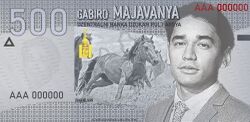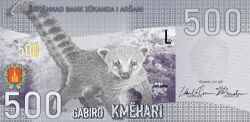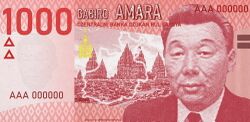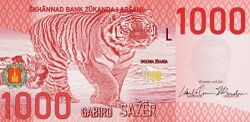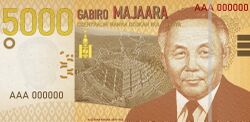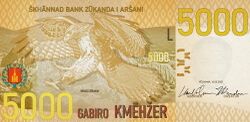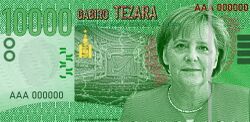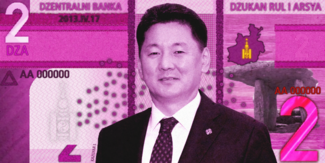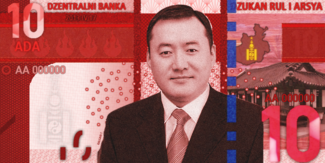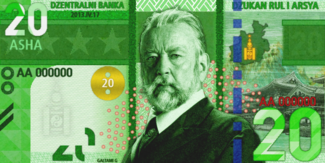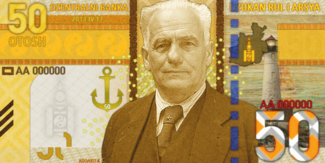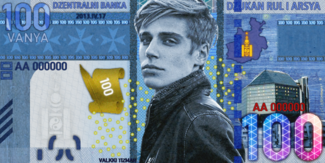Gabrielt Gabiro
| Gabiro (Gabrielt and Arsyan) | |
|---|---|
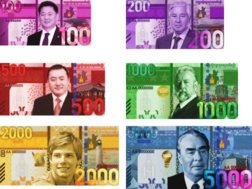 10th Gabiro Series (2018-2012) | |
| Unit | |
| Symbol | ɢ |
| Denominations | |
| Subunit | |
| 1/100 | Zaka |
| Symbol | |
| Zaka | z |
| Banknotes | |
| Freq. used | ɢ.100, ɢ.200, ɢ. 500, ɢ.1000, ɢ.2000 |
| Rarely used | ɢ.5000 |
| Coins | |
| Freq. used | 5z, 10z, 25z, 50z, ɢ.1 |
| Rarely used | 1z, ɢ.2 |
| Demographics | |
| Date of introduction | 17 April 1926 1 January 2000 |
| User(s) | |
| Issuance | |
| Central bank | Central Bank of Gabrielland and Arsya |
| Valuation | |
| Inflation | 1% |
The Gabiro is the currency of Gabrielland issued by the Central Bank of Gabrielland and Arsya. It is one of the 4 currencies of the Dokodo Union, and Gabrielland is bound to adopt the Quasa once it fulfills the necessary requirements to join the Quasa Zone.
It was introduced in 1926 as the new currency of the recently formed union of Gabrielland and Arsya, replacing the Gabrielt Taga and the Arsyan Lirtta. The name Gabiro was agreed upon in the first parliamentary meeting of the union on the 19th of April 1926 as a combination of the Gabrielt word gaba meaning "money" and the Arsyan word kvirro, also meaning money. In 1976, the Dzakwanist government abolished money, and the Gabrio ceased to become legal tender in Dzakwanist Gabrielland. It was kept as the official currency of the newly-formed Arsyan Republic until the 1st of January 1977 until it was replaced by the Arsyan Lirtta, which would become the currency until 1985 when it was replaced with the Convertible Lirtta. The Gabiro was reintroduced on the 1st of January 2000, replacing the Convertible Lirtta at par. Due to high rates of inflation sustained during the civil war and the Arsyan Republic period, the Gabiro underwent redenomination in 2009, with 1 new Gabiro being equal to 100 old Gabiros.
History
Predecessors
Both the Gabrielt and Arsyan confederations prior to 1926 have employed a currency union between member states tied to the value of silver. The Gabrielt Taga was used by almost all of the members in the Gabrielt confederation, with one notable exception being the State of Nevesia, while in the Arsyan confederation, it was universally accepted by all members, with subsets in the Grafenlandish Kingdom were allowed to retain their practice of minting and printing the Granfelnadish crown, though now with their value at par with the Lirtta, and its interchangeability with the Lirtta guaranteed. In essence, the Gabrielt Taga and the Arsyan Lirtta were interchangeable by their weight in silver or gold, and theoretically could be used in both confederations, though most merchants and traders were reluctant to do so in fears of low acceptability and the sudden debasement of the other currency.
The value of the Gabrielt Taga was fixed using the 5 Taga coin being equal to around 5.5g of fine silver, or the equivalent of 0.35g of fine gold. The Arsyan Lirtta was fixed using the 2½ Lirtta coin, known as the "Lirt" being equal to around 0.5g of fine gold, or the equivalent of 7.86g of fine silver. It could be inferred that 1 Taga was equal to 1.1g of fine silver, and 1 Lirtta being equal to around 3.15g of fine silver. It could be inferred that the conversion between the Gabrielt Taga and the Arsyan Lirtta was set at 1.1 : 3.15, or around 2.864 Tagas for each Lirtta, or around 0.349 Lirttas for each Taga. This figure would later be codified into the acts of friendship and unity of 1924, two years preceeding the unification of Gabrielland and the Arsyan Realms. The treaty also stipulated the acceptance of coins and banknote from both confederations in the other, thus creating a semi-monetary union between the two.
Negotiations would take place after in the months following the 1924 agreement. On the 21st of October 1924, prominent ministers and economists from both sides met in Vailhims to discuss a potential single currency and market for the two confederations, with the ultimate goal being unification of the two confederations. The high number of Gabrielt coins struck in silver in comparison to the high number of Arsyan coins struck in gold meant that there was an oversupply of silver in the Gabrielt confederation and an oversupply of gold in the Arsyan confederations. As a result, both the Taga and Lirtta deviated from its agreed value by as much as 15% depending on which commodity is sought after in the global stage. It was agreed that a single currency needed to be created and overseen by a single body to ensure that the government was able to maintain the set value agreed upon in the 1924 agreement.
The Gabrielt and Arsyan National Bank was created on the 12th of February 1925 in preparation for unification. The issuance and management of the Taga and the Lirtta was fully handed over to this bank in order to regain control over the fluctuating prices of both currencies. An equal number of coins were being struck in gold and silver, and a unified reserve means that banknotes being backed in either silver or gold could be printed accordingly. As the Taga and the Lirtta were under the helm of one unified bank, they both acted like a single currency, and therefore was the penultimate predecessor of the Gabiro. While the Taga and Lirtta were kept as separate currencies internationally, coins and banknotes bore both values in Taga and in Lirtta, simplifying economic transactions and cross-country trade. Fiscal policy was also united, thus bringing the end to Gabrielt and Arsyan monetary independence in favor of a unified monetary policy.
On the 19th of November 1925, a few months before independence, the Gabiro was proclaimed by the Gabrielt and Arsyan National Bank, overseen by the comittee for the unification of Gabrielland and the Arsyan Realms, as the new and sole currency of the new unified country. The Gabiro is a portmanteau of the Gabrielt word gaba meaning money, and Lirtta, the Arsyan word for money and the currency that once was circulated in the Arsyan realms. The Gabiro became the currency of Gabrielland upon unification in April of 1926.
Banknotes
The Gabrielt Gabiro has seen several banknote series being released into general circulation. A total of 9 separate banknote families have been released between 1926 and 2018, with the latest series being released in 2018. A 10th series is scheduled to be released in 2024. Below is a list of banknote families released by the Central Bank of Gabrielland and Arsya and their withdrawal date.
| Series | First Release | Withdrawal |
|---|---|---|
| 1 | 1 May 1926 | 1 January 1949 |
| 2 | 8 August - 17 September 1939 | 1 January 1964 |
| 3 | 11 May - 24 October 1954 | 1 January 1971 |
| 4 | 8 March 1961 | 1 January 1966 |
| 5 | 19 February 1965 | 1 January 1977 |
| 6 | 3 June 1973 | 1 January 1977 |
| 7 | 11 January 2001 | 1 January 2017 |
| 8 | 17 April 2009 | 1 January 2029 |
| 9 | 17 April 2017 | 1 January 2029 |
| 10 | 15 March 2024 | - |
7th series (2001)
The 7th series of the Gabiro was the fist series released by the Central Bank of Gabrielland and Arsya after its formation as the central bank of Gabrielland and Arsya. The series features national heroes from both Gabrielland and Arsya, as well as depicting national animals on the reverse side of the banknotes. This series did not have denominations that began with the numerla 2. The obverse side is written in standard Gabrielt, while the reverse side is in standard Arsyan.
8th series (2009)
The 8th series of the Gabiro was the first banknote family to be issued after redenomination. The number of denominations was slimmed down from 8 to 6, omitting ɢ.5, ɢ.10, ɢ.5000, and ɢ.10,000 (formerly ɢ.500, ɢ.1000, ɢ.500,000, and ɢ.1,000,000) while including new denominations of ɢ.200 and ɢ.2000 (formerly ɢ.20,000 and ɢ.200,000). The banknotes feature prominent Gabrielt and Arsyan poets, playrights, and other artists, celebrating their works and contribution towards the richness of Gabrielt culture and society on the obverse and selected Gabrielt landscapes and locations on the reverse. The banknotes have a more modern and updated look when compared to the 7th series
9th "Sontuvian" series (2017)
The 9th series of the Gabiro, more colloquiall known as the "Sontuvian" series after Finance Minister Gahttari Sontuvia, was first commissioned by the Central Bank of Gabrielland and Arsya around October of 2012, with a press report dated 15 October 2012 detailing the central bank's plan to further increase the safety and security of the Gabiro, as well as to keep the fresh look of the Gabiro. The ɢ.5000 bill was reintroduced while the ɢ.50 bill was omitted, instead being replaced by a trimetallic coin. Although released in 2017, notes still bear "2013" when the official bills were signed into law.
The series maintains the denominations found in previous bill, and carries the imprint "2013-2017".
10th series (2024)
On the 15th of June 2022, Central Bank Governor Kavan Samundiwan announced that a new family of banknotes is being prepared for release in mid-2024. Denominations are unlikely to change.
Coinage
These were the coins circulated before the adoption of the Quasa.
| Denomination | Obverse | Reverse | Value (Q) | Diameter (mm) | Thickness (mm) | Mass (g) | Composition | Edge | Latest Series | Withdrawn |
|---|---|---|---|---|---|---|---|---|---|---|
| Bzok (1b) | Valantas V | Emblem of Gabrielland | 0.0113 Q | 15.75 | 1.50 | 1.13 | Aluminum | Smooth | 2009 | 1 January 2028 |
| Ahkkahri II | Emblem of Arsya | 2007 | ||||||||
| Deers | Emblem of the New Frontier | 2014 | ||||||||
| Two Bzok (2b) | Valantas V | Emblem of Gabrielland | 0.0226 Q | 18.75 | 1.75 | 1.95g | 2008 | |||
| Ahkkari II | Emblem of Arsya | 2015 | ||||||||
| Cows | Emblem of the New Frontier | 2009 | ||||||||
| Fiver (5b) | Valkki Tahzimar | Emblem of Gabrielt State | 0.0565 Q | 23 | 2.10 | 2.87 | 1997 | |||
| Valantas V | Emblem of Gabrielland | 2009 | ||||||||
| Adayi (10b) | Valantas V | Emblem of Gabrielland | 0.113 Q | 22.55 | 2.15 | 3.4 | Copper plated steel | Milled | 2010 | |
| Ahkkari II | Emblem of Arsya | 2011 | ||||||||
| Tigers | Emblem of the New Frontier | 2015 | ||||||||
| Ahnimman Kazrul | Emblem of the Gabrielt State | 1997 | ||||||||
| Zaka (1z) | Valantas V | Emblem of Gabrielland | 0.226 Q | 25.15 | 2.45 | 4.45 | 2010 | |||
| Ahkarri II | Emblem of Arsya | 2008 | ||||||||
| Eagles | Emblem of the New Frontier | 2014 | ||||||||
| Eighter (2z) | Valantas V | Gabrielt Tazmak | 0.452 Q | 28.05 | 2.65 | 6.15 | Nordic gold | Fine Scallops | 2015 | |
| Ahkkari II | Emblem of Arsya | 2013 | ||||||||
| Falcons | Emblem of the New Frontier | 2014 | ||||||||
| Marak (4z) | Valantas V | Gabrielt Tazmak | 0.904 Q | 31.65 | 2.85 | 8.35 | 2015 | |||
| Ahkkari II | Emblem of Arsya | 2013 | ||||||||
| Monkeys | Emblem of the New Frontier | 2014 | ||||||||
| Halver (8z) | Valantas V | Gabrielt Tazmak | 1.808 Q | 31.65 | 3.05 | 9.65 | Bimetallic; Outer: Nordic gold Inner: Cupronickel |
Fine Milled | 2011 | |
| Ahkkari II | Emblem of Arsya | 2012 | ||||||||
| Gabiro (1ɢ) | Valantas V | Gabrielt Tazmak | 3.616 Q | 33.55 | 3.35 | 11.45 | Bimetallic; Outer: Nordic gold Inner: Nickel-Brass |
2013 | ||
| Ahkkari II | Emblem of Arsya | 2010 | ||||||||
| Double (2ɢ) | Valantas V | Gabrielt Tazmak | 7.232 Q | 37.15 | 3.65 | 14.55 | Trimetallic; Outer: Nordic gold Middle: Manganese bronze Inner: Cupro-Nickel |
Fine Milled, Edge Lettering | 2015 | |
| Ahkkari II | Emblem of Arsya | 2014 |
